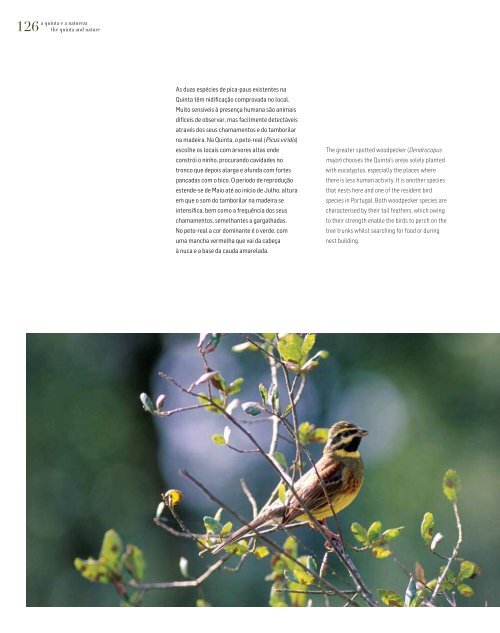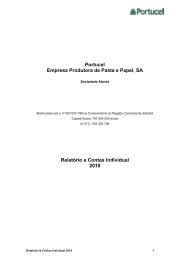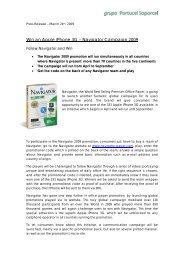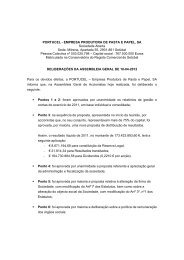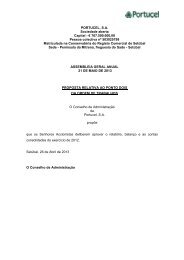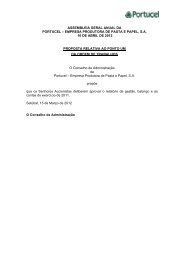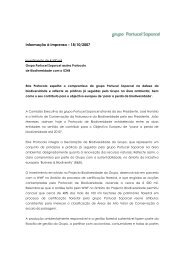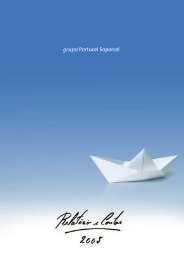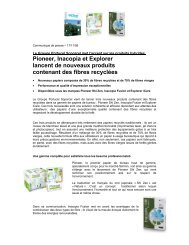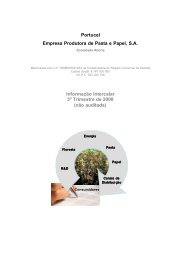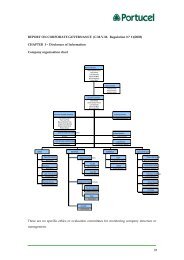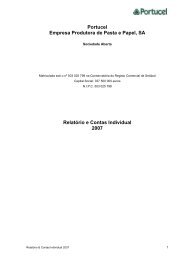Os Eucaliptos e as Aves da Quinta de São Francisco
Os Eucaliptos e as Aves da Quinta de São Francisco
Os Eucaliptos e as Aves da Quinta de São Francisco
You also want an ePaper? Increase the reach of your titles
YUMPU automatically turns print PDFs into web optimized ePapers that Google loves.
a quinta e a natureza<br />
a quinta e a natureza<br />
126 the quinta and nature the quinta and nature 127<br />
As du<strong>as</strong> espécies <strong>de</strong> pica-paus existentes na<br />
<strong>Quinta</strong> têm nidificação comprova<strong>da</strong> no local.<br />
Muito sensíveis à presença humana são animais<br />
difíceis <strong>de</strong> observar, m<strong>as</strong> facilmente <strong>de</strong>tectáveis<br />
através dos seus chamamentos e do tamborilar<br />
na ma<strong>de</strong>ira. Na <strong>Quinta</strong>, o peto-real (Picus viridis)<br />
escolhe os locais com árvores alt<strong>as</strong> on<strong>de</strong><br />
constrói o ninho, procurando cavi<strong>da</strong><strong>de</strong>s no<br />
tronco que <strong>de</strong>pois alarga e afun<strong>da</strong> com fortes<br />
pancad<strong>as</strong> com o bico. O período <strong>de</strong> reprodução<br />
esten<strong>de</strong>-se <strong>de</strong> Maio até ao início <strong>de</strong> Julho, altura<br />
em que o som do tamborilar na ma<strong>de</strong>ira se<br />
intensifica, bem como a frequência dos seus<br />
chamamentos, semelhantes a gargalhad<strong>as</strong>.<br />
No peto-real a cor dominante é o ver<strong>de</strong>, com<br />
uma mancha vermelha que vai <strong>da</strong> cabeça<br />
à nuca e a b<strong>as</strong>e <strong>da</strong> cau<strong>da</strong> amarela<strong>da</strong>.<br />
The greater spotted woodpecker (Dendrocopus<br />
major) chooses the <strong>Quinta</strong>’s are<strong>as</strong> solely planted<br />
with eucalyptus, especially the places where<br />
there is less human activity. It is another species<br />
that nests here and one of the resi<strong>de</strong>nt bird<br />
species in Portugal. Both woodpecker species are<br />
characterised by their tail feathers, which owing<br />
to their strength enable the birds to perch on the<br />
tree trunks whilst searching for food or during<br />
nest building.<br />
A escreve<strong>de</strong>ira é uma espécie característica do Norte do País.<br />
The cirl bunting is typical from the northern region of the country.<br />
Já o pica-pau-malhado (Dendrocopus major)<br />
escolhe <strong>as</strong> zon<strong>as</strong> <strong>de</strong> eucaliptal puro <strong>da</strong> <strong>Quinta</strong>,<br />
sobretudo nos pontos com menos activi<strong>da</strong><strong>de</strong><br />
humana. É outra d<strong>as</strong> espécies nidificantes na<br />
<strong>Quinta</strong> e uma d<strong>as</strong> aves resi<strong>de</strong>ntes em Portugal.<br />
Amb<strong>as</strong> <strong>as</strong> espécies <strong>de</strong> pica-paus são<br />
caracterizad<strong>as</strong> pel<strong>as</strong> pen<strong>as</strong> <strong>da</strong> cau<strong>da</strong>, b<strong>as</strong>tante<br />
fortes que servem <strong>de</strong> apoio no tronco quando<br />
buscam alimento ou constroem o ninho.<br />
Entre outr<strong>as</strong> espécies com nidificação<br />
confirma<strong>da</strong> na proprie<strong>da</strong><strong>de</strong> encontram-se o<br />
tentilhão (Fringilla coelebs), o chapim-real<br />
(Parus major) e o verdilhão-comum (Carduelis<br />
chloris). O tentilhão é d<strong>as</strong> espécies mais<br />
apreciad<strong>as</strong> em Portugal tanto pela sua beleza —<br />
o macho tem o peito e o ventre <strong>de</strong> um tom<br />
c<strong>as</strong>tanho-avermelhado, que contr<strong>as</strong>ta com a<br />
cabeça e a nuca <strong>de</strong> um cinzento-azulado — como<br />
pelo canto. Sociável, é d<strong>as</strong> aves mais facilmente<br />
observáveis na <strong>Quinta</strong> on<strong>de</strong> constrói o ninho,<br />
Amongst the other species with confirmed<br />
nesting in the property are the chaffinch (Fringilla<br />
coelebs), the great tit (Parus major) and the<br />
greenfinch (Carduelis chloris). The chaffinch is<br />
one of the most appreciated species in Portugal<br />
both for its beauty — the male’s reddish-brown<br />
chest and belly contr<strong>as</strong>t with the bluish-grey<br />
head and nape — and its singing. A sociable<br />
animal, it is one of the e<strong>as</strong>iest species to watch in<br />
the <strong>Quinta</strong> where it builds a perfect nest in the<br />
shape of a small bowl. Likewise, the great tit, the<br />
largest of all tits and the one which is busiest<br />
looking for artificial nests, is careful in building<br />
its own. I<strong>de</strong>ntifiable by its yellow belly with a<br />
black stripe, black head and white face, from<br />
March onwards it starts looking for a cavity in<br />
which to build its nest. It starts by filling it up<br />
with moss and then by lining it with fluff and hair.<br />
During the incubation period, the male is<br />
responsible for feeding the female with larva,


